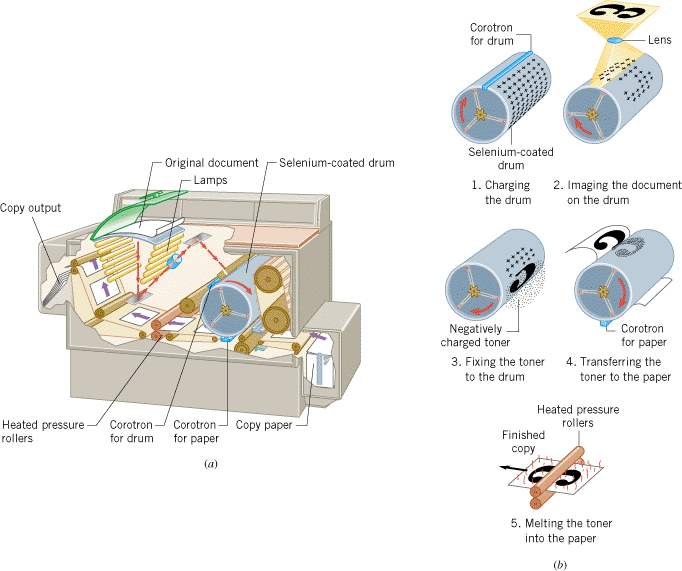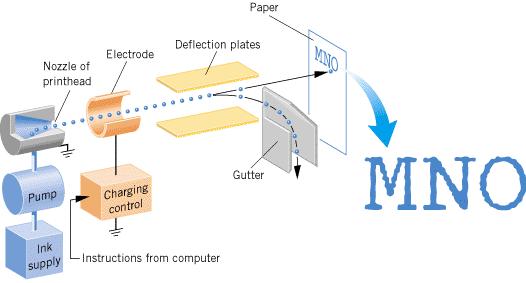The electrostatic force that charged particles exert on one another plays the central role in an office copier. The copying process is called xerography, from the Greek xeros and graphos, meaning “dry writing.” The heart of a copier is the xerographic drum, an aluminum cylinder coated with a layer of selenium (see Figure 18.37a). Aluminum is an excellent electrical conductor. Selenium, on the other hand, is a photoconductor; it is an insulator in the dark but becomes a conductor when exposed to light. Consequently, a positive charge deposited on the selenium surface will remain there, provided the selenium is kept in the dark. When the drum is exposed to light, however, electrons from the aluminum pass through the conducting selenium and neutralize the positive charge.
 | | Figure 18.37
(a) This cutaway view shows the essential elements of a copying machine. (b) The five steps in the xerographic process. |
|
The photoconductive property of selenium is critical to the xerographic process, as Figure 18.37b illustrates. First, an electrode called a corotron gives the entire selenium surface a positive charge in the dark. Second, a series of lenses and mirrors focuses an image of a document onto the revolving drum. The dark and light areas of the document produce corresponding areas on the drum. The dark areas retain their positive charge, but the light areas become conducting and lose their positive charge, ending up neutralized. Thus, a positive-charge image of the document remains on the selenium surface. In the third step, a special dry black powder, called the toner, is given a negative charge and then spread onto the drum, where it adheres selectively to the positively charged areas. The fourth step involves transferring the toner onto a blank piece of paper. However, the attraction of the positive-charge image holds the toner to the drum. To transfer the toner, the paper is given a greater positive charge than that of the image, with the aid of another corotron. Last, the paper and adhering toner pass through heated pressure rollers, which melt the toner into the fibers of the paper and produce the finished copy.
A laser printer is used with computers to provide high-quality copies of text and graphics. It is similar in operation to the xerographic machine, except that the information to be reproduced is not on paper. Instead, the information is transferred from the computer’s memory to the printer, and laser light is used to copy it onto the selenium–aluminum drum. A laser beam, focused to a fine point, is scanned rapidly from side to side across the rotating drum, as Figure 18.38 indicates. While the light remains on, the positive charge on the drum is neutralized. As the laser beam moves, the computer turns the beam off at the right moments during each scan to produce the desired positive-charge image, which is the letter “A” in the picture.
 | | Figure 18.38
As the laser beam scans back and forth across the surface of the xerographic drum, a positive-charge image of the letter “A” is created. |
|
An inkjet printer is another type of printer that uses electric charges in its operation. While shuttling back and forth across the paper, the inkjet printhead ejects a thin stream of ink. Figure 18.39 illustrates the elements of one type of printhead. The ink is forced out of a small nozzle and breaks up into extremely small droplets, with diameters that can be as small as 9 ×
× 10–6 m. About 150 000 droplets leave the nozzle each second and travel with a speed of approximately 18 m/s toward the paper. During their flight, the droplets pass through two electrical components, an electrode and the deflection plates (a parallel plate capacitor). When the printhead moves over regions of the paper that are not to be inked, the charging control is turned on and an electric field is established between the printhead and the electrode. As the drops pass through the electric field, they acquire a net charge by the process of induction. The deflection plates divert the charged droplets into a gutter and thus prevent them from reaching the paper. Whenever ink is to be placed on the paper, the charging control, responding to instructions from the computer, turns off the electric field. The uncharged droplets fly straight through the deflection plates and strike the paper.
10–6 m. About 150 000 droplets leave the nozzle each second and travel with a speed of approximately 18 m/s toward the paper. During their flight, the droplets pass through two electrical components, an electrode and the deflection plates (a parallel plate capacitor). When the printhead moves over regions of the paper that are not to be inked, the charging control is turned on and an electric field is established between the printhead and the electrode. As the drops pass through the electric field, they acquire a net charge by the process of induction. The deflection plates divert the charged droplets into a gutter and thus prevent them from reaching the paper. Whenever ink is to be placed on the paper, the charging control, responding to instructions from the computer, turns off the electric field. The uncharged droplets fly straight through the deflection plates and strike the paper.
 | | Figure 18.39
An inkjet printhead ejects a steady flow of ink droplets. Charged droplets are deflected into a gutter by the deflection plates, while uncharged droplets fly straight onto the paper. Letters formed by an inkjet printer look normal, except when greatly enlarged and the patterns from the drops become apparent. |
|
 |
| Copyright © 2000-2003 by John Wiley & Sons, Inc. or related companies. All rights reserved. |



![]() ×
×![]() 10–6 m. About 150 000 droplets leave the nozzle each second and travel with a speed of approximately 18 m/s toward the paper. During their flight, the droplets pass through two electrical components, an electrode and the deflection plates (a parallel plate capacitor). When the printhead moves over regions of the paper that are not to be inked, the charging control is turned on and an electric field is established between the printhead and the electrode. As the drops pass through the electric field, they acquire a net charge by the process of induction. The deflection plates divert the charged droplets into a gutter and thus prevent them from reaching the paper. Whenever ink is to be placed on the paper, the charging control, responding to instructions from the computer, turns off the electric field. The uncharged droplets fly straight through the deflection plates and strike the paper.
10–6 m. About 150 000 droplets leave the nozzle each second and travel with a speed of approximately 18 m/s toward the paper. During their flight, the droplets pass through two electrical components, an electrode and the deflection plates (a parallel plate capacitor). When the printhead moves over regions of the paper that are not to be inked, the charging control is turned on and an electric field is established between the printhead and the electrode. As the drops pass through the electric field, they acquire a net charge by the process of induction. The deflection plates divert the charged droplets into a gutter and thus prevent them from reaching the paper. Whenever ink is to be placed on the paper, the charging control, responding to instructions from the computer, turns off the electric field. The uncharged droplets fly straight through the deflection plates and strike the paper.